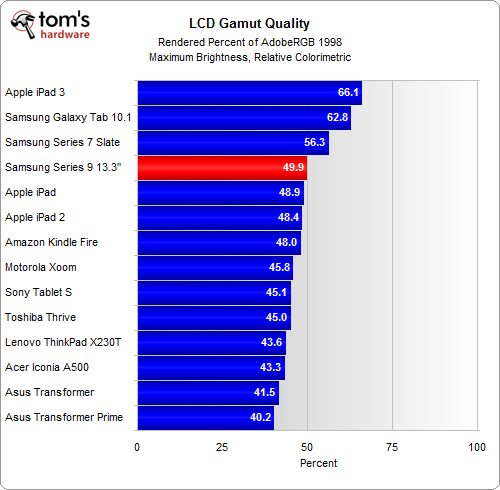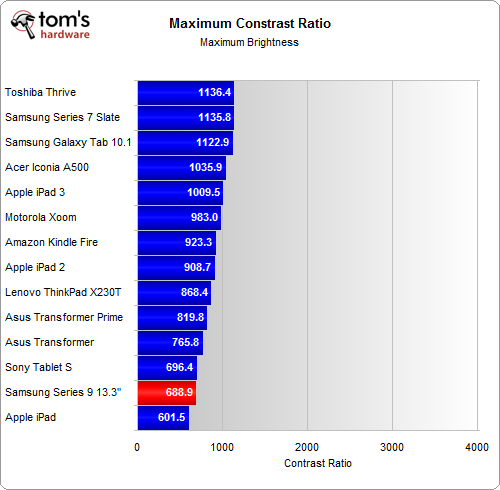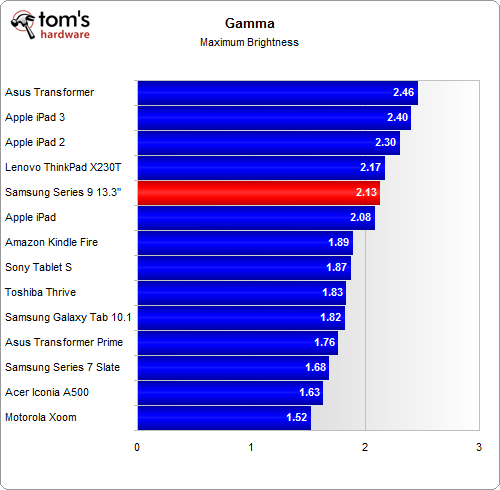Samsung's Series 9 13.3" Ultrabook For 2012: Thinner And Lighter
Display Performance: SuperBright Plus, Indeed

Samsung markets the display on its Series 9 as SuperBright Plus, and that name is fairly accurate. Images are crisp and colors are incredibly vivid. In fact, the new Series 9 reminds us a lot of the company's Galaxy Tab 10.1. Both sport IPS panels from the company's own factories, so our inclination might not be far off, either.

Rendering ~50% of the Adobe RGB (1998) gamut, the 13.3" Series 9 is close to the top of the list compared to many of the tablets and Ultrabooks we've tested. Notably, it bests the ThinkPad X230T, which is another business-oriented mobile platform. The larger gamut profile is a side effect of Samsung's IPS panel. Lenovo's setup employs a TN-based display.

Samsung claims its SuperBright Plus is capable of 400 nits, which is already pretty darn bright. Yet, our 13.3" Series 9 sample nearly achieves 450 nits, putting it on par with Apple's iPad 3. Again, this is a phenomenally crisp display, due in large part to its brightness. Unfortunately, high-luminance IPS displays are usually handicapped when it comes to contrast ratio. Blacks have a tendency to appear as dark grey. And indeed, we see this from our Series 9.



Get Tom's Hardware's best news and in-depth reviews, straight to your inbox.
Current page: Display Performance: SuperBright Plus, Indeed
Prev Page Transcoding Performance: Second-Gen Quick Sync Next Page Battery Performance: Four Hours Of Real-World Use-
mayankleoboy1 Is the QS balance between quality/speed determined by any OEM customised driver ?Reply
Because this samsung notebook takes more time than other i7's in 'quality' setting, but lesser time in 'performance' settings.
-
mayankleoboy1 in the screen quality/brightness benchmark, why u no compare with the new rMBP ?Reply -
joytech22 esreverDon't samsung ultra books overheat a lot?What..? No. That's the dell's and I'm not even joking.Reply
I was watching a demo and their Dell XPS ultrabooks with GT640's in them continuously overheated during the demos and lowered the FPS catastrophically low.
They have these ultrabooks at my local Jb HiFi (Well.. the i5 version at least) and it was cool to the touch and very solid (I've noticed even Acer's ultrabooks don't feel flimsy as sh*t like their notebooks). -
Yargnit Looks awesome, but unfortunately the 'ASUS Zenbook Prime UX31A' simply trounces it on a price/performance ratio. If there was a base model out for under $1200, preferably at $1000 like the Asus it'd be a very solid option. But the Asus for $1000 is just such a better value that it kind of make this look like a weak effort, which is too bad because it actually looks like a solid system.Reply -
ojas BTW i wish you'd have included a desktop processor's QuickSync benchmark for reference...Reply -
ojas Hmmm...interesting, one of the most positive review's i've seen of an ultrabook-class notebook...i just have two questions:Reply
1)Is the touchpad annoying? Compared to Apple's touchpads, for example.
2)Can you keep it in your lap, sitting or lying down slightly (you know, with the notebook against your knees)? Or does it get too warm?
These two are deal breakers for me, personally. So is the keyboard, but you've clearly stated what's wrong with that (touchpad too, but just wanted to know if it's a noticeable annoyance). -
veroxious BTW why was the Asus UX31A not used in the comparative benchmarks? We have the same form factor, Ivy Bridge i7 processor, 256GB SSD BUT the Asus sports a Full HD IPS panel that really impressed me for less money.Reply -
cangelini mayankleoboy1in the screen quality/brightness benchmark, why u no compare with the new rMBP ?I haven't gone out to buy one yet :)Reply